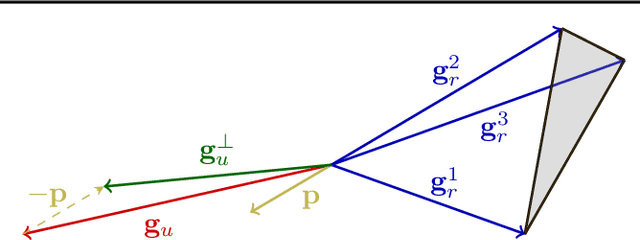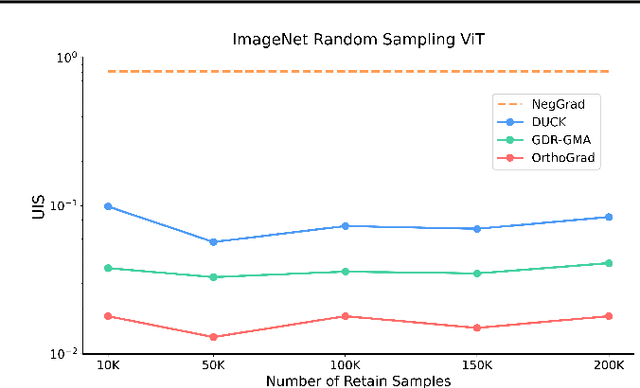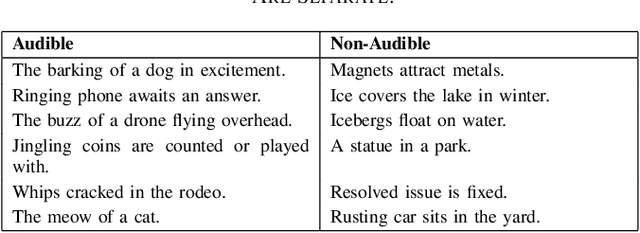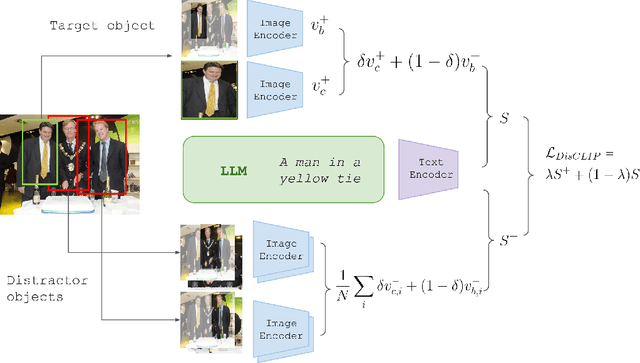Eitan Shaar
Adapting to the Unknown: Training-Free Audio-Visual Event Perception with Dynamic Thresholds
Mar 21, 2025Abstract:In the domain of audio-visual event perception, which focuses on the temporal localization and classification of events across distinct modalities (audio and visual), existing approaches are constrained by the vocabulary available in their training data. This limitation significantly impedes their capacity to generalize to novel, unseen event categories. Furthermore, the annotation process for this task is labor-intensive, requiring extensive manual labeling across modalities and temporal segments, limiting the scalability of current methods. Current state-of-the-art models ignore the shifts in event distributions over time, reducing their ability to adjust to changing video dynamics. Additionally, previous methods rely on late fusion to combine audio and visual information. While straightforward, this approach results in a significant loss of multimodal interactions. To address these challenges, we propose Audio-Visual Adaptive Video Analysis ($\text{AV}^2\text{A}$), a model-agnostic approach that requires no further training and integrates a score-level fusion technique to retain richer multimodal interactions. $\text{AV}^2\text{A}$ also includes a within-video label shift algorithm, leveraging input video data and predictions from prior frames to dynamically adjust event distributions for subsequent frames. Moreover, we present the first training-free, open-vocabulary baseline for audio-visual event perception, demonstrating that $\text{AV}^2\text{A}$ achieves substantial improvements over naive training-free baselines. We demonstrate the effectiveness of $\text{AV}^2\text{A}$ on both zero-shot and weakly-supervised state-of-the-art methods, achieving notable improvements in performance metrics over existing approaches.
Go Beyond Your Means: Unlearning with Per-Sample Gradient Orthogonalization
Mar 04, 2025



Abstract:Machine unlearning aims to remove the influence of problematic training data after a model has been trained. The primary challenge in machine unlearning is ensuring that the process effectively removes specified data without compromising the model's overall performance on the remaining dataset. Many existing machine unlearning methods address this challenge by carefully balancing gradient ascent on the unlearn data with the gradient descent on a retain set representing the training data. Here, we propose OrthoGrad, a novel approach that mitigates interference between the unlearn set and the retain set rather than competing ascent and descent processes. Our method projects the gradient of the unlearn set onto the subspace orthogonal to all gradients in the retain batch, effectively avoiding any gradient interference. We demonstrate the effectiveness of OrthoGrad on multiple machine unlearning benchmarks, including automatic speech recognition, outperforming competing methods.
Classifier-Guided Captioning Across Modalities
Jan 03, 2025



Abstract:Most current captioning systems use language models trained on data from specific settings, such as image-based captioning via Amazon Mechanical Turk, limiting their ability to generalize to other modality distributions and contexts. This limitation hinders performance in tasks like audio or video captioning, where different semantic cues are needed. Addressing this challenge is crucial for creating more adaptable and versatile captioning frameworks applicable across diverse real-world contexts. In this work, we introduce a method to adapt captioning networks to the semantics of alternative settings, such as capturing audibility in audio captioning, where it is crucial to describe sounds and their sources. Our framework consists of two main components: (i) a frozen captioning system incorporating a language model (LM), and (ii) a text classifier that guides the captioning system. The classifier is trained on a dataset automatically generated by GPT-4, using tailored prompts specifically designed to enhance key aspects of the generated captions. Importantly, the framework operates solely during inference, eliminating the need for further training of the underlying captioning model. We evaluate the framework on various models and modalities, with a focus on audio captioning, and report promising results. Notably, when combined with an existing zero-shot audio captioning system, our framework improves its quality and sets state-of-the-art performance in zero-shot audio captioning.
DisCLIP: Open-Vocabulary Referring Expression Generation
May 30, 2023



Abstract:Referring Expressions Generation (REG) aims to produce textual descriptions that unambiguously identifies specific objects within a visual scene. Traditionally, this has been achieved through supervised learning methods, which perform well on specific data distributions but often struggle to generalize to new images and concepts. To address this issue, we present a novel approach for REG, named DisCLIP, short for discriminative CLIP. We build on CLIP, a large-scale visual-semantic model, to guide an LLM to generate a contextual description of a target concept in an image while avoiding other distracting concepts. Notably, this optimization happens at inference time and does not require additional training or tuning of learned parameters. We measure the quality of the generated text by evaluating the capability of a receiver model to accurately identify the described object within the scene. To achieve this, we use a frozen zero-shot comprehension module as a critique of our generated referring expressions. We evaluate DisCLIP on multiple referring expression benchmarks through human evaluation and show that it significantly outperforms previous methods on out-of-domain datasets. Our results highlight the potential of using pre-trained visual-semantic models for generating high-quality contextual descriptions.
 Add to Chrome
Add to Chrome Add to Firefox
Add to Firefox Add to Edge
Add to Edge